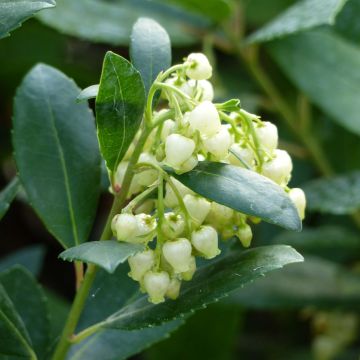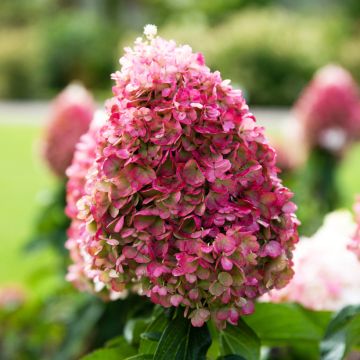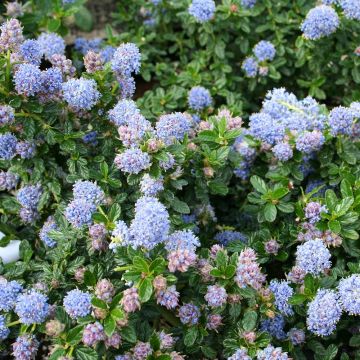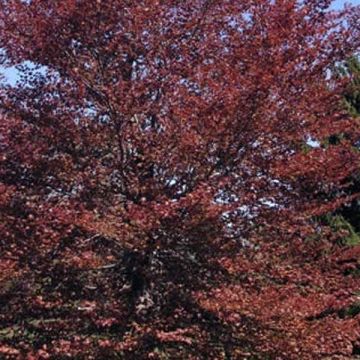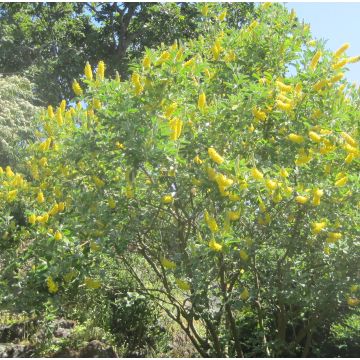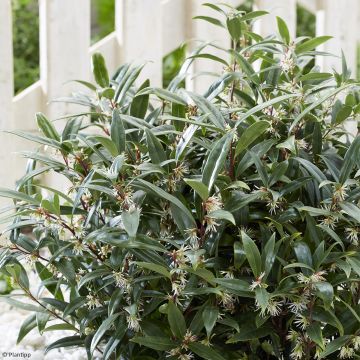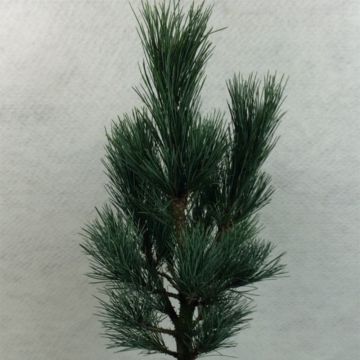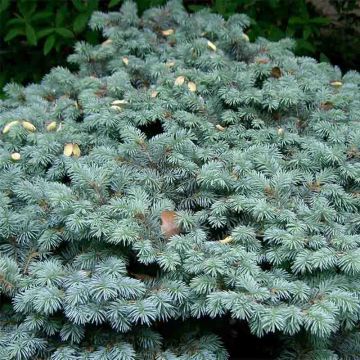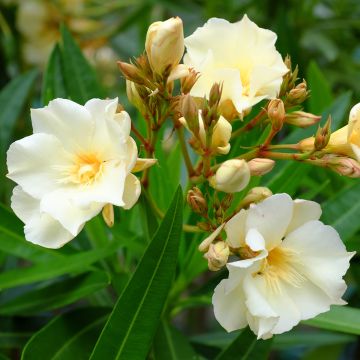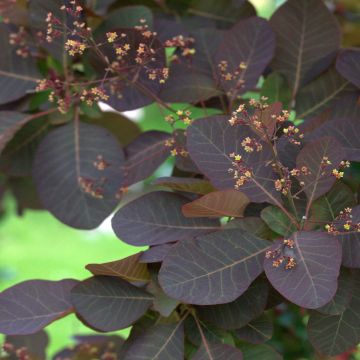Plantfit
Log in / Register
Existing customer?
New customer?
Create an account to track your orders, access our customer service and, if you wish, make the most of our upcoming offers.
My Account
Hello
Shipping country and language
Your country of residence may be:
For a better user experience on our website, you can select:
Your shipping country:
Andorra
Austria
Belgium
Bulgaria
Croatia
Czechia
Denmark
Estonia
Finland
France
Germany
Greece
Hungary
Iceland
Ireland
Italy
Latvia
Lithuania
Luxembourg
Monaco
Netherlands
Poland
Portugal
Romania
Slovakia
Slovenia
Spain
Sweden
Switzerland
Language:
French
English
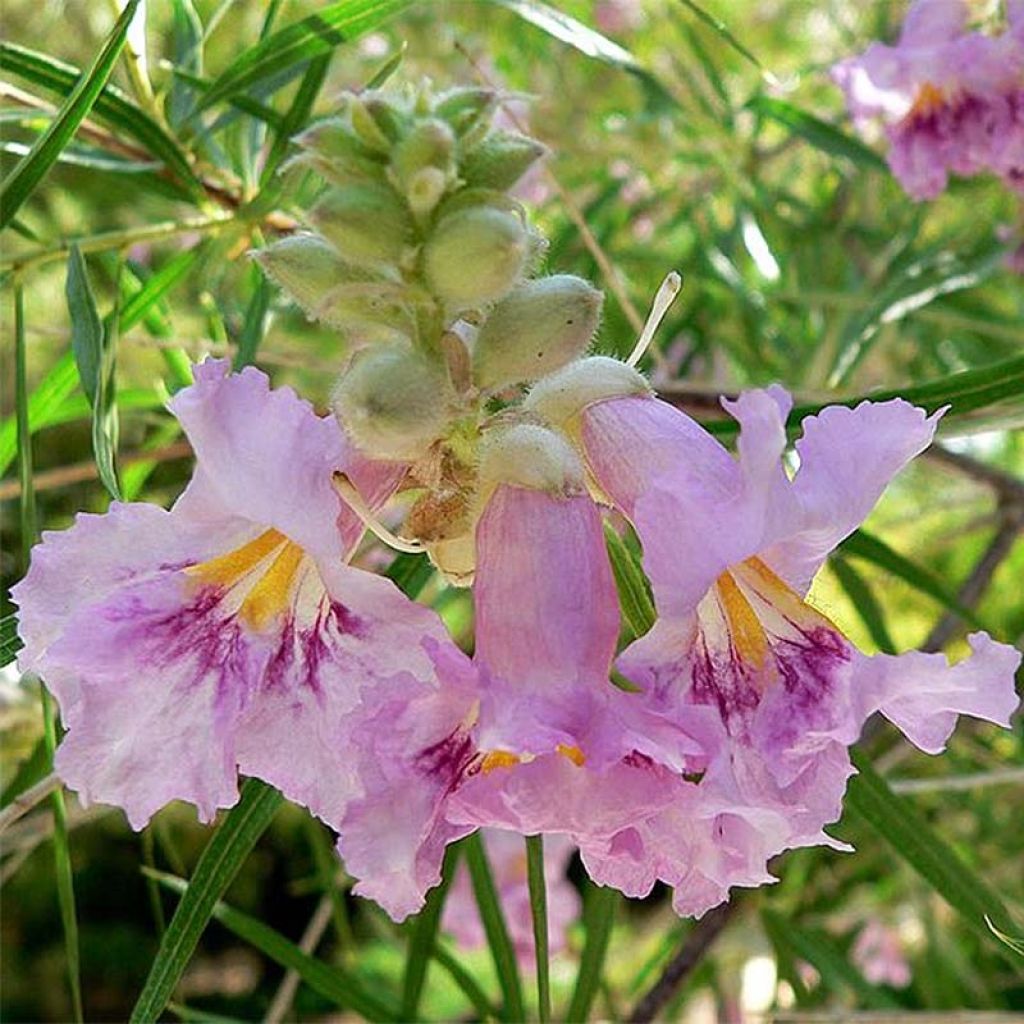

Chilopsis linearis
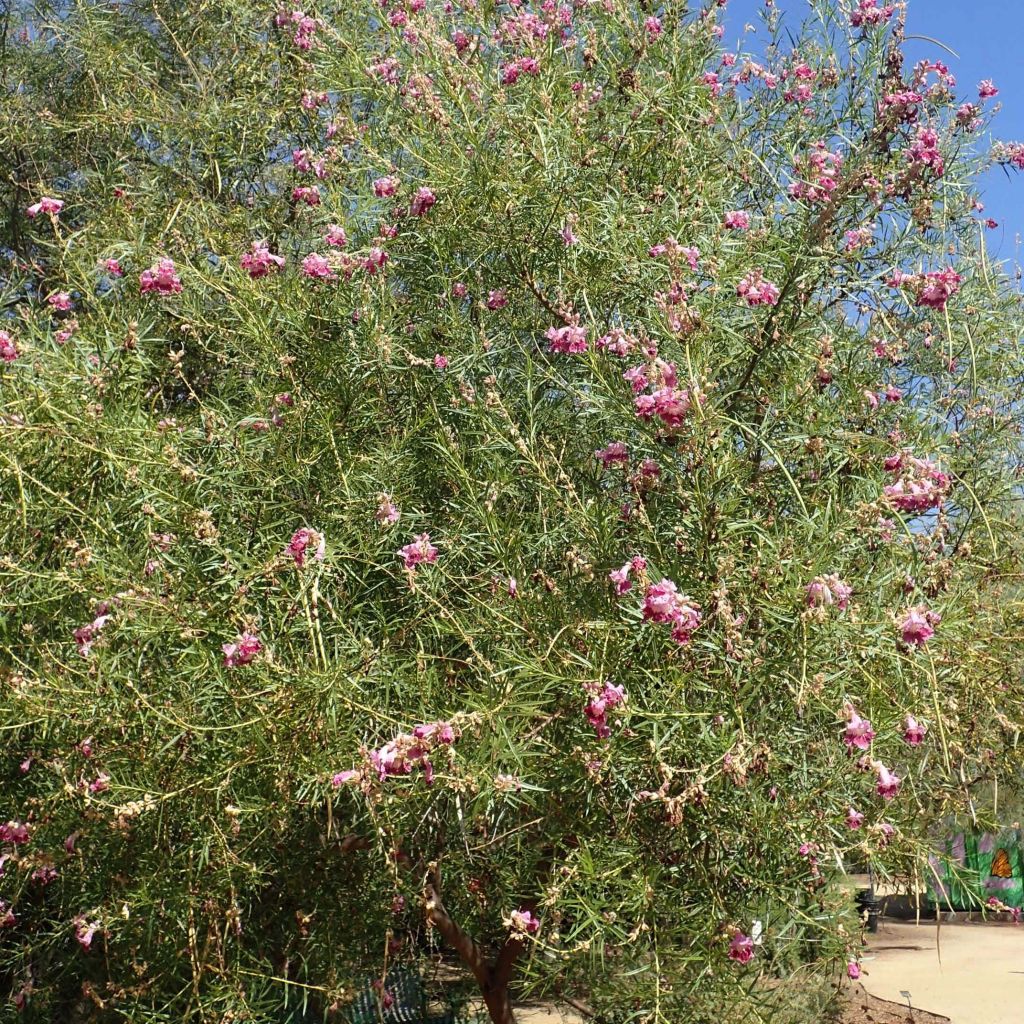

Chilopsis linearis - Saule du désert
Chilopsis linearis
Chilopsis linearis
Desert Willow, Desert Catalpa
Ordered in a 12-15 L size, first forgotten in the package (yes, it happens Cerise!) finally received a beautiful specimen matching the presentation photo. Planted facing south with a mix of gravel and crushed tiles to ensure drainage. The foliage is starting to emerge (end of April). Waiting for it to establish and for the next colourful flowering.
Nathalie, 25/04/2023
Order in the next for dispatch today!
Dispatch by letter from 3,90 €.
Delivery charge from 5,90 € Oversize package delivery charge from 6,90 €.
More information
This item is not available in your country.
Shipping country:
 Andorra
Andorra Austria
Austria Belgium
Belgium Bulgaria
Bulgaria Croatia
Croatia Czechia
Czechia Denmark
Denmark Estonia
Estonia Finland
Finland France
France Germany
Germany Greece
Greece Hungary
Hungary Iceland
Iceland Ireland
Ireland Italy
Italy Latvia
Latvia Lithuania
Lithuania Luxembourg
Luxembourg Monaco
Monaco Netherlands
Netherlands Poland
Poland Portugal
Portugal Romania
Romania Slovakia
Slovakia Slovenia
Slovenia Spain
Spain Sweden
Sweden Switzerland
SwitzerlandSelect delivery date,
and select date in basket
This plant carries a 24 months recovery warranty
More information
We guarantee the quality of our plants for a full growing cycle, and will replace at our expense any plant that fails to recover under normal climatic and planting conditions.
Oversize package: home delivery by special carrier from 6,90 € per order.
Express home delivery from 8,90 €.
From 5,90 € for pickup delivery and 6,90 € for home delivery
Express home delivery from 8,90 €.

Would this plant suit my garden?
Set up your Plantfit profile →
Description
Chilopsis linearis owes its nickname of desert willow to its graceful habit, the resemblance of its long leaves to those of the willow, and its desert origins. A unique tree with pink trumpet-shaped flowers in summer. It is exotic yet hardy, and remarkably understated. It is still rare in our gardens despite its numerous qualities. Graceful, original, and compact, it should quickly become indispensable for ornamenting gardens subjected to long summer droughts.
Chilopsis linearis belongs to the Bignoniaceae family, just like catalpa and red trumpet vine. It is native to semi-desert areas in the southwest United States and Mexico, where it grows in full sun in poor soil, often near dried-up watercourses, in gravel pits and on ravines. Its roots, which penetrate very deeply into the soil, allow it to withstand long months without water. Its cold resistance is around -12° C to -15° C (10.4° F to 5° F) if planted in well-drained soil. It tolerates salt spray and saline soils, as well as limestone. Its growth is slow during the establishment phase, then it accelerates.
Left to its own devices, the desert willow forms a small tree with an occasionally irregular habit, about 4 m to 5 m (13.1 ft to 16.4 ft) in all directions, carried by flexible branches. It has one or several short trunks, giving rise to rather low branching. Its deciduous leaves appear late in spring, in April-May, and fall late in autumn. They are tough, linear, narrow, tapering, recurved, and 10 cm to 20 cm (3.9 in to 7.9 in) long and 4 mm (0.2 in) wide. They are a fairly dark green. Flowering is abundant in June, and it continues sporadically throughout the summer. The flowers are arranged in conical clusters and are erect, measuring 10 cm to 30 cm (3.9 in to 11.8 in) long, at the terminal part of the branches, on the current year's wood. The flowers, about 2.5 cm (1 in) wide, are tubular and campanulate in shape, composed of 5 lobes, three of which are wider at the base and two smaller ones with highly undulate margins at the top. Their colour varies depending on the individuals, ranging from purple to dark pink, magenta, lavender blue, and white-pink, with a yellow throat or streaked with purple or aubergine. They are slightly fragrant and are pollinated by bees, especially by the large black carpenter bee. The fruits are long green pods shaped like beans, containing numerous seeds with bristles. They will be dispersed by the wind.
Chilopsis linearis is a true desert plant. Along with Red Yucca (Hesperaloe parviflora) and the dasylirions, it is one of the best plants for landscaping arid areas of the garden, from the seaside to the inland. It is not demanding on soil type as long as it is well-drained, and is perfectly drought-resistant once well-established. It is a valuable asset for dry gardens that are so lacking in summer flowers. It can be planted on its own to lightly shade a terrace, for example, or in the centre of a bed with perennials or dry soil shrubs (desert sage Leucophyllum frutescens, Salvia chamaedryoides, lavender), but away from other trees and always away from waterpipes. To accompany it, you can choose Silver Caragana (Halimodendron halodendron), Ceanothus 'Concha', or Mexican buckeye (Ungnadia speciosa), whose flowering periods are staggered. Chilopsis linearis can also be grown in a large pot to adorn a terrace.
Chilopsis linearis in pictures
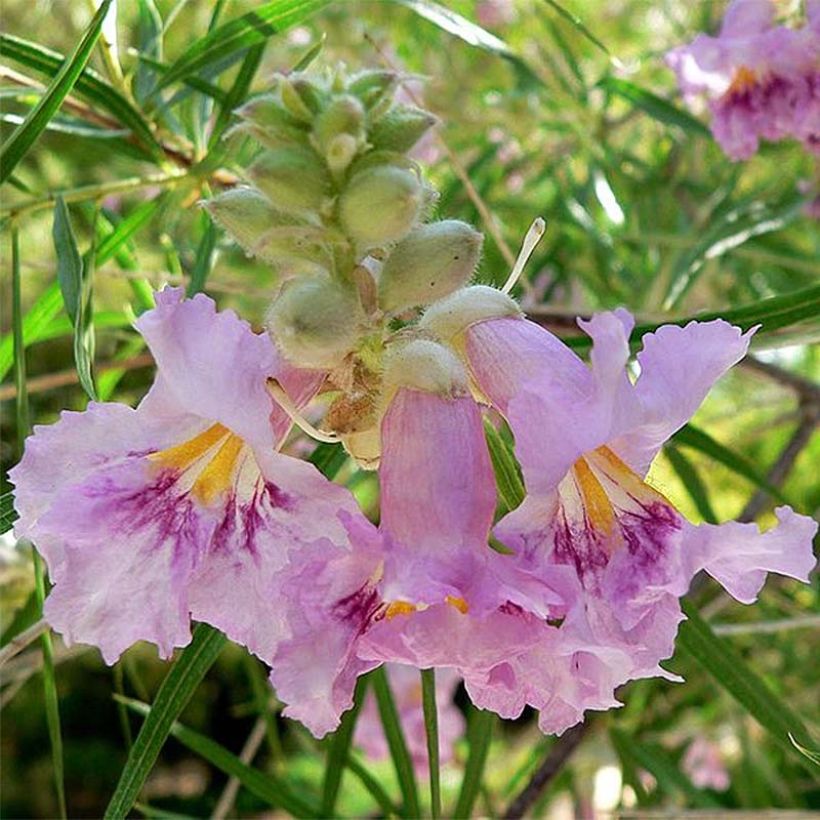

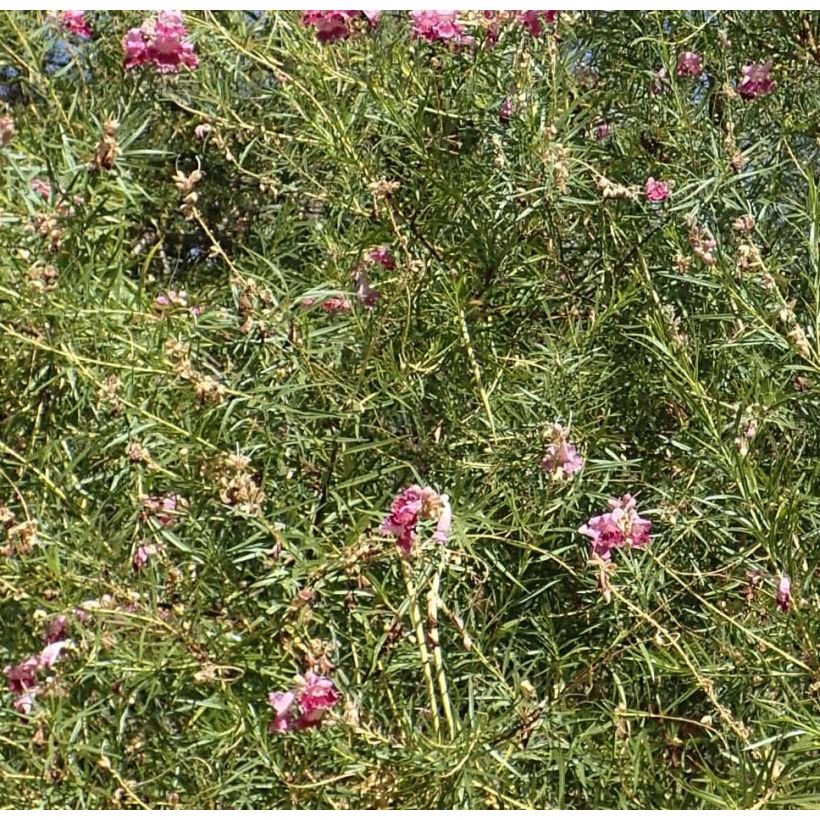



Plant habit
Flowering
Foliage
Botanical data
Chilopsis
linearis
Bignognaceae
Desert Willow, Desert Catalpa
North America
Planting and care
In regions with cold winters, plant from March to May. In regions with hot and dry summers, plant from September to November. From its origins, it has maintained a clear preference for long and hot summers. It requires very well-drained, loose, deep, sandy or gravelly soil, poor in organic matter. It will not tolerate soils that are wet in winter, as this can harm its hardiness. The presence of limestone is well tolerated. The substrate must be kept moist during the first summer or the first two summers, then this young plant completely eliminates the need for watering, even in hot and very dry climates. Plant in full sun and away from competition with other trees. If pruning is necessary (for training as a standard or tree), do so at the end of winter. To obtain a bushy subject, it is perfectly possible to prune short at the end of winter, without harming flowering. The vegetation of this bush restarts late, in May, depending on the regions. The desert willow does not appreciate organic fertilisers.
Bushes grown in large pots will require regular watering in summer.
Planting period
Intended location
Care
- , onOrder confirmed
Reply from on Promesse de fleurs
Haven't found what you were looking for?
Hardiness is the lowest winter temperature a plant can endure without suffering serious damage or even dying. However, hardiness is affected by location (a sheltered area, such as a patio), protection (winter cover) and soil type (hardiness is improved by well-drained soil).

Photo Sharing Terms & Conditions
In order to encourage gardeners to interact and share their experiences, Promesse de fleurs offers various media enabling content to be uploaded onto its Site - in particular via the ‘Photo sharing’ module.
The User agrees to refrain from:
- Posting any content that is illegal, prejudicial, insulting, racist, inciteful to hatred, revisionist, contrary to public decency, that infringes on privacy or on the privacy rights of third parties, in particular the publicity rights of persons and goods, intellectual property rights, or the right to privacy.
- Submitting content on behalf of a third party;
- Impersonate the identity of a third party and/or publish any personal information about a third party;
In general, the User undertakes to refrain from any unethical behaviour.
All Content (in particular text, comments, files, images, photos, videos, creative works, etc.), which may be subject to property or intellectual property rights, image or other private rights, shall remain the property of the User, subject to the limited rights granted by the terms of the licence granted by Promesse de fleurs as stated below. Users are at liberty to publish or not to publish such Content on the Site, notably via the ‘Photo Sharing’ facility, and accept that this Content shall be made public and freely accessible, notably on the Internet.
Users further acknowledge, undertake to have ,and guarantee that they hold all necessary rights and permissions to publish such material on the Site, in particular with regard to the legislation in force pertaining to any privacy, property, intellectual property, image, or contractual rights, or rights of any other nature. By publishing such Content on the Site, Users acknowledge accepting full liability as publishers of the Content within the meaning of the law, and grant Promesse de fleurs, free of charge, an inclusive, worldwide licence for the said Content for the entire duration of its publication, including all reproduction, representation, up/downloading, displaying, performing, transmission, and storage rights.
Users also grant permission for their name to be linked to the Content and accept that this link may not always be made available.
By engaging in posting material, Users consent to their Content becoming automatically accessible on the Internet, in particular on other sites and/or blogs and/or web pages of the Promesse de fleurs site, including in particular social pages and the Promesse de fleurs catalogue.
Users may secure the removal of entrusted content free of charge by issuing a simple request via our contact form.
The flowering period indicated on our website applies to countries and regions located in USDA zone 8 (France, the United Kingdom, Ireland, the Netherlands, etc.)
It will vary according to where you live:
- In zones 9 to 10 (Italy, Spain, Greece, etc.), flowering will occur about 2 to 4 weeks earlier.
- In zones 6 to 7 (Germany, Poland, Slovenia, and lower mountainous regions), flowering will be delayed by 2 to 3 weeks.
- In zone 5 (Central Europe, Scandinavia), blooming will be delayed by 3 to 5 weeks.
In temperate climates, pruning of spring-flowering shrubs (forsythia, spireas, etc.) should be done just after flowering.
Pruning of summer-flowering shrubs (Indian Lilac, Perovskia, etc.) can be done in winter or spring.
In cold regions as well as with frost-sensitive plants, avoid pruning too early when severe frosts may still occur.
The planting period indicated on our website applies to countries and regions located in USDA zone 8 (France, United Kingdom, Ireland, Netherlands).
It will vary according to where you live:
- In Mediterranean zones (Marseille, Madrid, Milan, etc.), autumn and winter are the best planting periods.
- In continental zones (Strasbourg, Munich, Vienna, etc.), delay planting by 2 to 3 weeks in spring and bring it forward by 2 to 4 weeks in autumn.
- In mountainous regions (the Alps, Pyrenees, Carpathians, etc.), it is best to plant in late spring (May-June) or late summer (August-September).
The harvesting period indicated on our website applies to countries and regions in USDA zone 8 (France, England, Ireland, the Netherlands).
In colder areas (Scandinavia, Poland, Austria...) fruit and vegetable harvests are likely to be delayed by 3-4 weeks.
In warmer areas (Italy, Spain, Greece, etc.), harvesting will probably take place earlier, depending on weather conditions.
The sowing periods indicated on our website apply to countries and regions within USDA Zone 8 (France, UK, Ireland, Netherlands).
In colder areas (Scandinavia, Poland, Austria...), delay any outdoor sowing by 3-4 weeks, or sow under glass.
In warmer climes (Italy, Spain, Greece, etc.), bring outdoor sowing forward by a few weeks.

